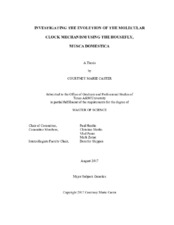| dc.description.abstract | Mapping the evolution of the transcriptional feedback loops that regulate the circadian clock will lead to the understanding of how this essential pacemaker allows insects to anticipate changes in their environment. Transcriptional feedback loops were first discovered in Drosophila, and while there is extensive conservation to mammals, it is evident that different insects have diverged or adopted different mechanisms to construct their circadian clocks. Here, we investigate the divergence of the clock in dipterans by characterizing the evolution of molecular clock mechanisms from the model organism Drosophila to another dipteran, the housefly (Musca domestica).
In Drosophila the core feedback loop is composed of the core components: Clock (Clk), cycle (cyc), period (per), timeless (tim), clockwork orange (cwo), and cryptochrome (Cry1). CLK binds CYC to initiate the feedback loop, and together they drive transcription of per and tim. PER:TIM heterodimers then repress their own transcription by binding to and inhibiting CLK:CYC. In addition, CWO is a transcriptional repressor which synergizes with PER to repress CLK:CYC activation. Insects such as monarch butterflies, however, appear to have an ancestral clock, possessing not only the Drosophila clock genes but also mammalian components such as the cycle ortholog (Bmal1) and a mammalian cryptochrome, cry2. In mice and “ancestral-like” insect clocks, BMAL1 contains the main transactivation domain of the CLK:BMAL1 complex. In these insects CRY2 also takes the place of Drosophila PER as the main transcriptional repressor.
Examination of the genomic sequences of M. domestica identified both the core
Drosophila clock genes and the ancestral clock gene, cry2. However, further analysis, showed that mdCry2 is in fact a (6-4) DNA photolyase. Furthermore, characterization of the circadian clock in the housefly and its comparison to the Drosophila clock revealed the functional genetic differences in their transcriptional feedback loops. Indeed, in the housefly CWO appears to have taken on the role of Drosophila PER as the main transcriptional repressor. This work confirms that the organization of the clock has diverged during insect evolution, and that there are multiple genetic approaches to regulating overt rhythmicity. | en |


